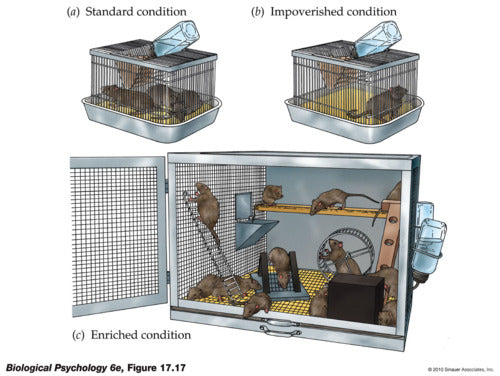Environmental Enrichment for Your RatsWhile it may not be a new series of studies, these that I stumbled across recently have definitely sparked my interest! The studies all had the same main focus- to show that changes in an animal’s environment, and the ways in which that animal reacts to those changes, can have significant long-term effects on the brain and behavior. |
 |
| Lab rats are normally reared under standard conditions during which they are housed alone with few objects. If instead the animals are reared under enriched environments, the memory functions are improved. If housed in impoverished conditions, similar to those of the standard, memory functions are impaired. Environmental enrichment is known to enhance memory performance in various learning tasks, including performance on a maze. The hippocampus, the brain region essential in learning and memory, is most affected by rearing in an enriched or impoverished environment. The study showed that rearing animals in an enriched environment elevates brain levels. |
| I found these manuscripts interesting as they more or less confirmed that we rat owners aren't really that crazy to want to practically create miniature playgrounds in our rats' cages! We can all agree that not only does having a stimulating environment for our rats please us- we like the bright colors and watching our furry friends play, but we know that giving them things to do makes them happier, and essentially healthier, pets. In the study, the rats lived in very similar conditions such as both groups were in the same rack in the same kind of plastic cages with wire lids. They both had regular bedding and water changes and unlimited access to food and water. But that is where the similarities end. The environmentally enriched rats lived in larger cages with a buddy and toys such as blocks, balls, and tubes. Toys were rotated twice a week and new toys were added weekly. They also had access to a playroom (5 ft by 5 ft) with additional toys (such as plastic tubing, small balls, plastic boxes, wire brushes, and paper towels to shred) for 45 minutes every other day and handled daily. This is what most of us rat enthusiasts do already for our ratties. In a different, but similar study, voluntary wheel running showed as to enhance spatial learning. Enriched rats did better than isolated rats with a running wheel. The barren environment rats lived alone with no toys, handled only 3 times a week, and were allowed to exercise in an empty room, also measuring 5 ft x 5 ft, 3 times a week for only 15 minutes. BORING! And sad! And to think, that is better than the life of a feeder rat..with the exception that they have the company of other rats. I learned that some of the things that the researchers did for the environmentally enriched rats could very well be considered some very good guidelines for all rat owners and is something I want to be sure is passed along to new rat owners especially. So how can you provide an enrichment environment for your rats? Environmental enrichment is best defined as the intentional manipulation of your rats' surroundings to affect their physical and mental well being in a positive way. You want to encourage natural behaviors such as foraging, social interaction with other rats, and keep them active while decreasing any unnatural or unwanted behaviors such as pacing, self and companion mutilation, aggression, and obesity. |
| 1. Never keep a single rat, rats do best in pairs or more. They sleep, groom, and play together. We hear it all the time on the forums how so-and-so only had one rat and it was so bonded to them...yada yada yada. Not denying that, but many of the reasons most people give as to why they are keeping a single rat tend to be more for their benefit than the rat’s. Rats need other rats. Pure and simple...that's a firm belief of mine. I’ll go more into this at another time. There is the exception with some rats that simply will not tolerate a companion but spaying or neutering the rat will usually solve this problem. 2. Supply your rats with toys at all times. Bird toys, cat toys, dog toys, and human infant toys are just some examples of what rats like to play with. I have some human infant rattles that make the perfect rolling toy for my ratties to push around their cage. Even just an empty toilet paper cardboard roll makes a fascinating toy if you stick something tasty inside. Be sure to follow my blog as I hope to continue posting about all the neat things you can use as toys for your rats! |

Pip grooming Emerson while Cicero snuggles up next to him |

Stealth Wheel |
| The most common toy is the wheel. Wheels keep your rats active and fit. While some rats don't seem to have any interest in their wheels, mostly as a result of whether or not they had any exposure to them at an early age, a wheel is a necessity for rats. Buy the largest you can fit into their cage, nothing less than 12 inch diameter for adult rats - and let them have access to it 24/7. Aim for sold wheels verses those made with bars or mesh which could potentially injure your rats legs, toes, or tail. |
| You can encourage a rat's natural behavior of having to actively seek out and find food with a toy called the Buffet Ball. This clear roll-around ball engages your active ratties' mind and bodies. With a little creativity, the Buffet Ball can be a different toy every day - simply fill with small pet treats or hay, and then place on the floor of cages, habitats, or any flat surface where your small pet is allowed to play. Slots in the ball challenge your small pet to puzzle out the treats he can see inside. As long as you make sure the food is in small enough pieces to eventually fall out, the rats will not chew on the ball. |

Buffet Ball |
| 3. Rotate your rats toys twice a week, even if just means rearranging the layout of things inside the cage to keep them interested. Change where the hammocks are hung. Switch out the jingly cat ball with a mylar crinkly one instead! Many companies now offer Build Your Own Toys where you can interchange various toy components to make a new toy whenever you feel like it, or replace the worn pieces. Many parrot toy websites offer them as well. |

Mylar ball |
| 4. Add new toys as often as possible. We could easily spend a fortunate on toys for our rats so think outside the box when it comes to every day items- just keep your rat’s safety in mind at all times. Sometimes we just need to get creative! This blog will be a good source for new ideas! Here is one for starters: provide new and interesting scents such as putting a bit of the water from a can of tuna on a single scrap of paper and then burying that scrap in a box filled with other shreds of paper...a paper dig box! Your rat will use its natural foraging behavior to locate that one scrap of paper with the tantalizing scent of fish! |
5. Provide your rats with exercise outside their cage in a safe alternative environment for a minimum of 45 minutes every day. Rats like to hide so tunnels made from tubes and boxes make excellent hideouts and are great additions to their out-of-cage, or free range, as I call it, time.
6. Handle your rats on a daily basis...who can resist giving those rat bellies a kiss every morning anyhow???

Aniston getting some one-on-one time with me |





